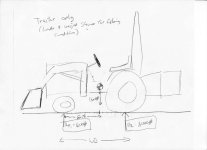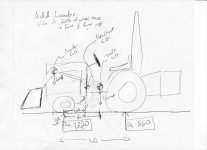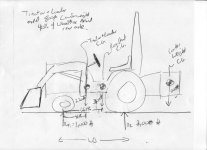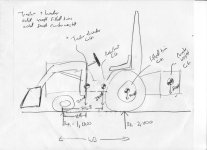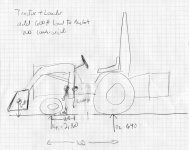OK class – today we are going to learn about
free body diagrams – no this isn’t sex education

it is Statics – significantly more boring.

The discussion at hand is weather adding wheel weights or filling the rear tires will lighten the load on the front axle. The short answer is that it will
not lessen the magnitude of the load on the front axle, but it
will change the weight distribution between the front & rear axle. For the steering question at hand, the steering performance (given the possibly undersized cylinder) the magnitude of the weight on the axle is what matters.
I’ve tried to use real world numbers (from my TC18). I apologize in advance for the sloppy drawings. I’m not much of an artist. The diagrams are on flat ground – no slopes taken into account.
Figure 1
Baseline tractor only
Tractor weight 1,600#
Total weight 1,600#
Dist of CG from front axle 62.5% of wheel base
Front axle load 600#
Rear axle load 1,000#
Front axle distribution 37.5%
Rear axle distribution 62.5%
Figure 2
Tractor + Loader (CG of loader is 20% of wheel base in FRONT of front axle)
Tractor weight 1,600#
Loader weight 600#
Total weight 2,200#
Dist of CG from front axle 40% of wheel base
Front axle load 1,320#
Rear axle load 880#
Front axle distribution 60%
Rear axle distribution 40%
You can see that the load on the front axle has more than doubled
Figure 3
Tractor + Loader add 400# filled Rear Tires (CG of liquid is at rear axle)
Tractor weight 1,600#
Loader weight 600#
Filled tire weight 400#
Total weight 2,600#
Dist of CG from front axle 49.3% of wheel base
Front axle load 1,320#
Rear axle load 1,280#
Front axle distribution 50.7%
Rear axle distribution 49.3%
Note that while the % of weight on the front axle has decreased from 60% to 50.7% the weight is still 1,320#
Figure 4
Tractor + Loader add 800# counter weight (CG of weight is 40% of wheel base behind rear axle)
Tractor weight 1,600#
Loader weight 600#
Counter weight 800#
Total weight 3,000 #
Dist of CG from front axle 66.7% of wheel base
Front axle load 1,000#
Rear axle load 2,000 #
Front axle distribution 33.3%
Rear axle distribution 66.7%
Both % and total weight on front axle are lower
Figure 5
Tractor + Loader add 800# counter weight and fill rear tires 400#
Tractor weight 1,600#
Loader weight 600#
Counter weight 800#
Filled tire weight 400#
Total weight 3,400 #
Dist of CG from front axle 70.6% of wheel base
Front axle load 1,000#
Rear axle load 2,400 #
Front axle distribution 29.4%
Rear axle distribution 70.6%
Further reduction in % of weight on front axle, but still the same total weight as figure 4. So why bother weighting rear tires? For traction of course – it also lowers the CG to make for more stable platform.
Figure 6
Tractor + Loader add 600# load to bucket (CG of loadt is 40% of wheel base in front of front axle) no counterweight or filled tires
Tractor weight 1,600#
Loader weight 600#
Bucket load 600#
Total weight 2,800 #
Dist of CG from front axle 23% of wheel base
Front axle load 2,160#
Rear axle load 640 #
Front axle distribution 77%
Rear axle distribution 23%
Now we have 3.6 times the original front axle load & a whopping 77% of the weight distribution on the front axle. You can see why we need to properly ballast when using the FEL.
Class dismissed – go out and get some seat time.
